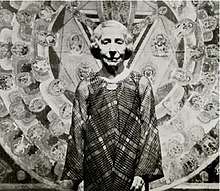Stella Kramrisch

Stella Kramrisch (1896-1993) was a cosmopolitan art historian, who was well known as a specialist in Indian art and Hinduism. She researched and taught Indian art history for more than six decades on three continents. After writing her dissertation on the essence of early-buddhist sculpture in India, she was invited to teach at Kala Bhavana in Shantiniketan (1922-24), from where she went on to a teaching post at Calcutta University (1924-1950). In Europe Kramrisch worked at the Courtauld Institute, London (1937-1940). From 1950, she was professor at the University of Pennsylvania in the Department of South Asia Regional Studies, where she had been recruited by W. Norman Brown, in addition to being a curator at the Philadelphia Museum of Art.[1]
Early life and education in Vienna
Stella Kramrisch was born on May 29, 1896 in Nikolsburg, now Mikulov, in Austria.[2] She was trained as a ballet dancer growing up in Austria. When Kramrisch was about 10 her parents moved to Vienna. One day she came across a translation of the Bhagavadgita: "I was so impressed it took my breath away."[3] She had found what she wanted to do in her life. She enrolled at the University of Vienna, studying at the department of art history with Professors Max Dvořák and Josef Strzygowski. She focused her studied on Indian art and culture. Thus she learned Sanskrit and read philosophy, literature and anthropology. In 1919, she successfully completed her studies by earning her doctorate.[4]
Art historical work in India
That year she traveled to London in 1919 as part of a university delegation to give three lectures at Oxford. Rabindranath Tagore heard her speak and invited her to come to India and teach at the Visva-Bharati University in Santiniketan in 1922. She was appointed professor of Indian art at the University of Calcutta in 1924, where she taught until 1950. In 1924 her first monograph "Essence of Indian art"[5] was published in German, which was reviewed widely in various journals throughout Europe. In the 1920s Kramrisch kept travelling to Vienna to give lectures. Various articles of her colleagues in Vienna appear as English translations in the Journal of the Indian Society of Oriental Art, which Kramrisch edited from 1933 onwards together with Abanindranath Tagore. Her seminal publication "Indian sculpture" (1933) was a profound analysis of Indian sculpture, conceptualized in size and format to function as an actual handbook.[6] After the British left India in 1947, her husband Laszlo Nemenyi opted to work for the new government of Pakistan and moved to Karachi. In 1950 he was found shot dead on a beach. Only after this, she finally moved permanently to the United States. While in India, she had converted to Hinduism, and begun a collection of South Asian art, later left to the Philadelphia Museum of Art.[7]
Curator of Indian art at the Philadelphia Museum of Art
Stella Kramrisch was the Professor of South Asian Art at the University of Pennsylvania for a long period of time. She was also the curator of Indian art at the Philadelphia Museum of Art from 1954 until 1972, and was a Curator Emeritus until her death.[4] In 1981 she curated Manifestations of Shiva, a large-scale exhibition of Indian art and sculpture at the Museum, which was met with both critical and popular success.[8] Her books include The Hindu Temple (1946, still in print in India), "Principles of Indian Art", and the encyclopedic "The Presence of Siva". She was a friend of the ballerina, designer, actress, and collector Natacha Rambova. Barbara Stoler Miller and Wayne E. Begley were among her students. Prof. Kramrisch was succeeded by Michael W. Meister, who is currently the W. Norman Brown Professor of South Asia Studies and History of Art at the University of Pennsylvania.
Death
Kramrisch died on September 2, 1993 at her home in Philadelphia, Pennsylvania.[2]
Honors
In 1982 the Indian government awarded Kramrisch with its Padma Bhushan award.[4] In 1985 she was awarded the prestigious Charles Lang Freer Medal by the Smithsonian Institution.[4]
Legacy
At the time of her death, Kramrisch left a bequest of 25 works to the Philadelphia Museum of Art.[4] In addition, Kramrisch's curatorial position was officially re-titled as the Stella Kramrisch Curator at the Philadelphia Museum of Art, a position which still exists today.[9]
References
- ↑ Stoller Miller, Barbara (1983). Exploring India's Sacred Art. Selected Writings of Stella Kramrisch. Philadelphia: University of Pennsylvania Press. pp. 3–33. ISBN 0812211340.
- 1 2 "Stella Kramrisch, Indian-Art Expert and Professor, 97", The New York Times, Retrieved 1 January 2015.
- ↑ A Meeting Of Art, India And Devotion - Page 2 - Philly.com
- 1 2 3 4 5 Sozanski, Edward J. "Indian Art Expert S. Kramrisch Dies at 97", Philly.com, Retrieved 1 January 2015.
- ↑ Kramrisch, Stella (1924). Grundzüge der Indischen Kunst. Hellerau, Dresden: Avalun Verlag.
- ↑ Kramrisch, Stella (1933). Indian Sculpture. The Heritage of India Series. London/New York: Oxford University Press.
- ↑ Dictionary of Art Historians
- ↑ "History: 1980-1990", Philadelphia Museum of Art, Retrieved 1 January 2015.
- ↑ "Historical Note", Philadelphia Museum of Art, Retrieved 1 January 2015.
External links
| Wikimedia Commons has media related to Stella Kramrisch. |